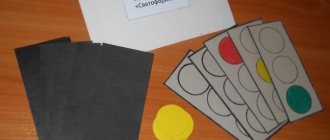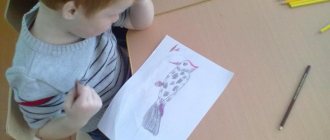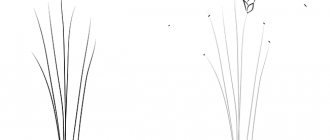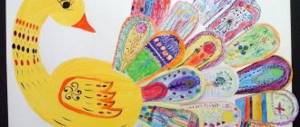Collective creativity in the visual activities of preschool children
Preschool childhood is the most important stage in a child’s development. During this period, all the general abilities needed by an adult in any type of activity develop.
In order to introduce children to the spiritual values of society, it is necessary, first of all, to form the moral and aesthetic qualities of the individual. Therefore, many domestic and foreign teachers consider the processes of moral and patriotic education of children in close connection.
Moral and aesthetic education can be achieved using different means, one of the important ones is the visual activities of children, including drawing, modeling and appliqué. As a rule, in kindergarten classes, children perform the image individually, each with their own work. But the children get special satisfaction from creating common pictures, compositions where the images of all the children in the group are combined; such pictures are called collective. Children are especially pleased by the overall result, which in this case is always richer in content and makes a more vivid impression on them than work done individually; they understand that together they can get a more significant image than each individual. In the process of collective activity, favorable conditions are created for children to communicate with each other and the teacher about what they are creating and how best to do it. Upon completion of the image, the children all rejoice at the results of their joint activity; joyful feelings unite them. Collective work evokes admiration among the children, truly, as in the poem by V. Mayakovsky: “What one cannot do, we will do together.”
The inclusion of children in collective creative work activates, which is expressed in independent reasoning, develops the desire to control their own actions, joint activities contribute to the formation of positive relationships in children with peers, and teaches them to provide help to those who need it.
A feature of visual activity that distinguishes it from other types of artistic creativity of children is that its result (drawing, sculpture, appliqué) does not disappear the moment the child stops the actions of creating an image, as happens in musical, theatrical and other types of artistic creativity of children . The image created by children remains, it can be examined, evaluated, compared, and improved. In collective activities, not only the overall result is assessed, but also the contribution of each participant in the overall work. All this requires careful consideration of the organization of the collective form of image creation, the selection of content that is interesting for all children.
The use of collective forms of work in artistic creativity will be most effective if collective activity is made emotional, easily feasible, promotes the development of imagination, and awareness of one’s contribution to the overall result. Entertaining game situations, artistic and pedagogical dramatization techniques promote interest in collective activities.
An important circumstance determining the need to introduce a collective form of organizing art activities is that preschool children really like this kind of work. Here everyone feels involved in the resulting common product, which makes the children very happy, and as a result, the picture created together is the most impressive, affecting the children emotionally much more strongly.
The collective form does not reduce the importance of each child’s activity, does not ignore his own efforts, and the overall result depends on the quality of each student’s work: after all, the better the child performs his part of the image, the more beautiful and interesting the overall composition will be. And the most important thing is that children understand that everyone together can create a more significant image than each individual. In the process of collective work, favorable conditions are created for children to communicate with each other and the teacher about what they are creating and how best to do it, and upon completion of the image, everyone rejoices at the results of their joint activity, joyful feelings unite them.
To solve the problem of developing collective creativity, the teacher needs to be based on the following principles:
– creative realization of each student as a condition for the development of collective co-creation;
– taking into account the individual characteristics of children when determining their role place in collective interaction;
– managerial direction in staging the process of collective activity;
– the child’s comfort in a group of peers.
When organizing collective activities, there is a 3rd stage: the preparatory stage, which allows children to deepen their own knowledge on the topic of future work, to form in them vivid images that generate a desire to embody them in their own visual activities. For this purpose, you can use excursions, conversations, viewing reproductions, etc.
The main stage is the work execution stage, which includes planning, executing and evaluating team work. Its goal is to provide children with the opportunity to embody images of the surrounding world in compositions, to create, during collective visual creativity, conditions for the creative interaction of children, promoting not only the aesthetic and artistic development of children, but also the formation of their skills to work in a team.
The final period is the period of interaction between children and already completed work.
The guidance of the teacher at different stages of the implementation of the plan for collective creative activity has its own distinctive features. At the first stage, when collective actions are planned, the teacher strives to create motivation - the emergence in each child of a desire to get involved in a collective activity.
The next step is to distribute the roles of the upcoming activity among the children.
There is another option for organizing children’s cooperation; it lies in the fact that the common goal of the activity is carried out by several subgroups and the result depends on the quality of the work of each of the subgroups. Such activities give children a feeling of satisfaction; each child has a feeling of usefulness and personal contribution to the common cause.
The final stage of collective creativity is associated with the achievement, awareness and assessment of the significance of the result obtained. At the same time, the teacher draws the children’s attention to everyone’s personal contribution to the common cause, emphasizing that without common efforts, the implementation of the collective plan would be impossible.
Children's collective artistic activity should be closely related to play. This connection is determined by the commonality of play and visual activity: both activities reflect the impressions children receive from the world around them. The use of gaming methods and techniques in collective classes increases the effectiveness of collective activities.
For the successful introduction of collective visual activity into the pedagogical process of kindergarten as one of the important forms of creative activity, a practical classification of the types of its organization is needed. This will allow teachers to understand the essence of children's collective activity and the form of its organization in each specific case. Soviet psychologists dealing with the problems of joint activity (V.G. Aseev, F.D. Gorbov, A.I. Dontsov, etc.) identified three main forms of its organization:
- Joint-individual (a child participating in an activity performs part of the work individually, and at the final stage it becomes part of the overall composition).
So, before conducting a combined lesson on the topic “Zoo”, at the first stage the children and I got acquainted with different animals from books, drawings, photographs, some visited the zoo. When planning, during the conversation we found out who liked which animal best, who would like to draw whom. In advance of the lesson, we prepared sheets of colored paper with vertical slits, which we glued onto white sheets of different sizes, since everyone’s animals will be different. When the children drew the animals, they cut them out and carefully glued them under strips of colored paper - and as a result, a zoo was born. The work ended with the game “Excursion to the Zoo”, during which the children told interesting facts about their animal, how they live, what they eat, etc.
- Collective visual activity based on a jointly sequential form of organization (the result of an action performed by one becomes the subject of the activity of another).
During a lesson on the topic “Fairy Tales,” the guys and I decided to come up with our own fairy tale. At the beginning of the lesson, all children were given sheets of paper - pages of the future book. During the collective discussion, the main character was identified, the plot was outlined, then the first child named his sentence, for example: “In a magical land there lived a lonely prince,” the second: “He was very rich,” the third: “Once he met a poor old woman on the road.” . Then the fourth, fifth, and so on, all the children in the group take turns continuing the story.
We wrote down the proposals expressed by the children on sheets of paper, and the pupils drew their own pictures on them in accordance with the invented proposal. The pages were assigned the corresponding numbers -1, 2, 3, etc. Then a group of children was assigned to make a cover, after drawing, all the pages were stapled and the result was a book, written and illustrated collectively.
- Collaborative-interacting (it is possible for all participants to work simultaneously, coordinating actions at each stage).
At a lesson in visual arts (modeling) on the topic “Road Signs,” the children were divided into pairs, for each of which blanks were made from sticks and paper circles. The couple’s task is to fashion their own specific road sign, which they previously met. In this case, children in pairs decide who will sculpt which parts. At the end of the work, the guys themselves placed all the signs on the “City” model.
Thus, the choice of different forms of conducting collective classes gives the teacher the opportunity for creativity in the field of specific pedagogical tools - choosing topics, developing content, methods, techniques.
Collective creativity helps children gain experience in creative cooperation, promotes the formation of patience, the ability to take into account the opinion of a friend, and a respectful attitude towards the work of others. In the process of collective work, the child’s emotional background is enriched, which is based on the expectation of an unknown effect from the completion of the work being created, and the sphere of emotions in preschool age plays a significant role in the development of creative activity.
The need for collective activity is always associated with pronounced positive emotions, therefore, for its development it is necessary to create, strengthen, and develop a feeling of pleasure and joy from creative activity. Creative abilities in collective activities help to formulate their own point of view, instill in children confidence in their own strengths and interest in other opinions, are complex, active in nature, ensuring the subjective position of each participant and develop important organizational, communicative, constructive, analytical skills, also forming children responsibility, initiative, independence. Introducing children to the creativity of their comrades makes them kinder, more sympathetic, and more attentive to each other and to the entire world around them.
From the above we can conclude that preschool age provides excellent opportunities for the development of visual creativity. And the creative potential of an adult will largely depend on the extent to which these opportunities were used.
Educators and parents face a task of extreme importance: to ensure that each of those who now goes to kindergarten is raised not only as a conscious member of our society, not only as a healthy and strong person, but also - necessarily! - an initiative, thinking person, capable of a creative approach to any business he undertakes. An active life position can have a basis if a person thinks creatively, if he sees around him an opportunity for improvement. Collective work in the field of visual activities can give children the opportunity to gain practical experience of moral relations.
Literature:
- Vygotsky L.S. Imagination and creativity in childhood / L.S. Vygotsky. - M.: Pedagogy, 1991. - 276 p.
- Grigorieva G.G. Development of a preschooler in visual arts. - M., 2004. - 193 p.
- Doronova T.N. Development of children in visual arts // Child in kindergarten. - No. 4. - 2008. - 21-29; No. 5. - 2008. - 3-13.
- Komarova T.S., Antonova A.V., Zatsepina M.B. "Beauty. Joy. Creativity": Aesthetic education program for children aged 2-7 years. - M.: Pedagogical Society of Russia, 2009.-128 p.
- Komarova T.S., Savenkov A.I. Collective creativity of children. Tutorial. M.: “Russian Pedagogical Agency”, 1998. -106 p.
- From birth to school. Basic educational program of preschool education / Ed. N. E. Veraksy, T. S. Komarova, M. A. Vasilyeva. — 3rd ed., revised. and additional -M.: MOSAIC - SYNTHESIS, 2016. - 368 p.
- Sakulina N., Komarova T. Visual activities in kindergarten. - M., 2007. - 202 p.
Senior group. Senior preschool age. Children 5-6 years old
Group work on drawing with elements of the application “Beauty Autumn” in the senior group
Autumn is a beautiful and wonderful time. No wonder Alexander Sergeevich Pushkin considered autumn the most favorite time of the year. Generous autumn gives us the last warm days of the year, painting everything around in bright, amazing and fabulous colors. And autumn is also rich in various gifts of nature...
Collective work on making a board game on traffic rules in a senior speech therapy group
Playing with your own hands is the best gift Collective work on making a board game on traffic rules in a senior speech therapy group Printed board games are a special category of games that, unlike others, require from participants not only attention, logical thinking,…







